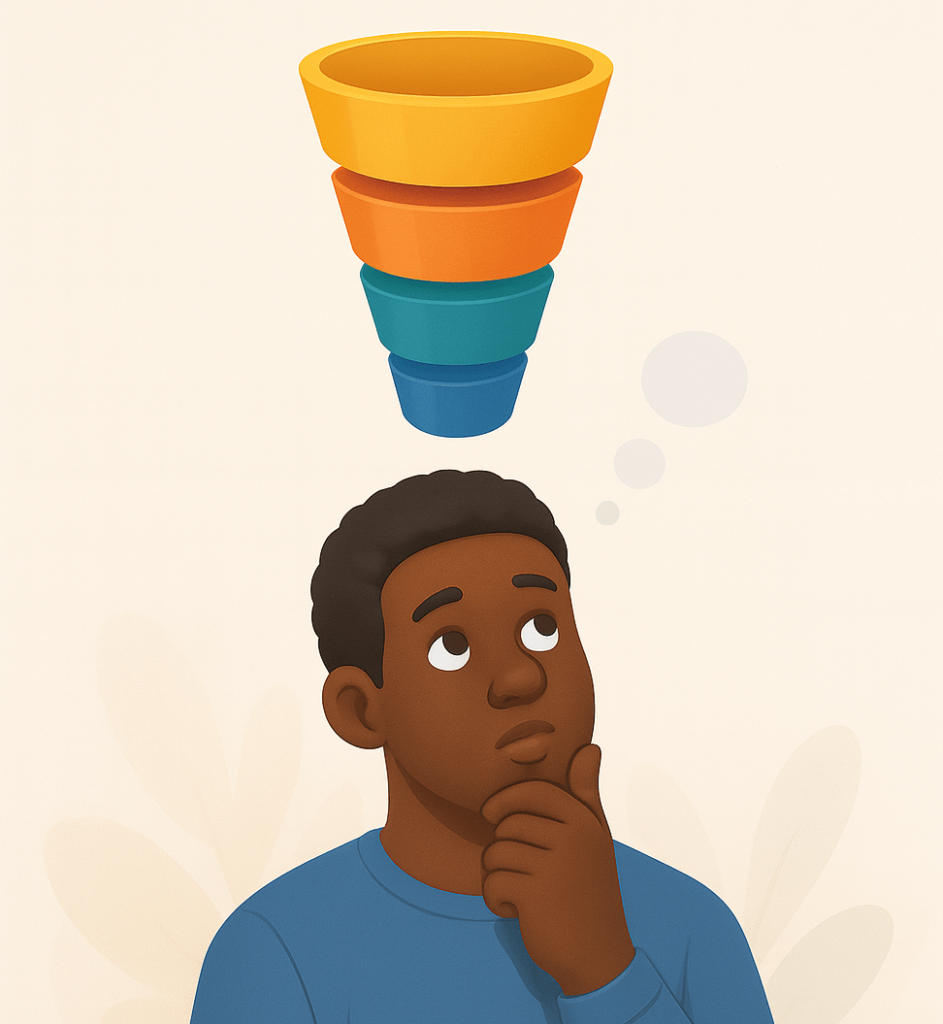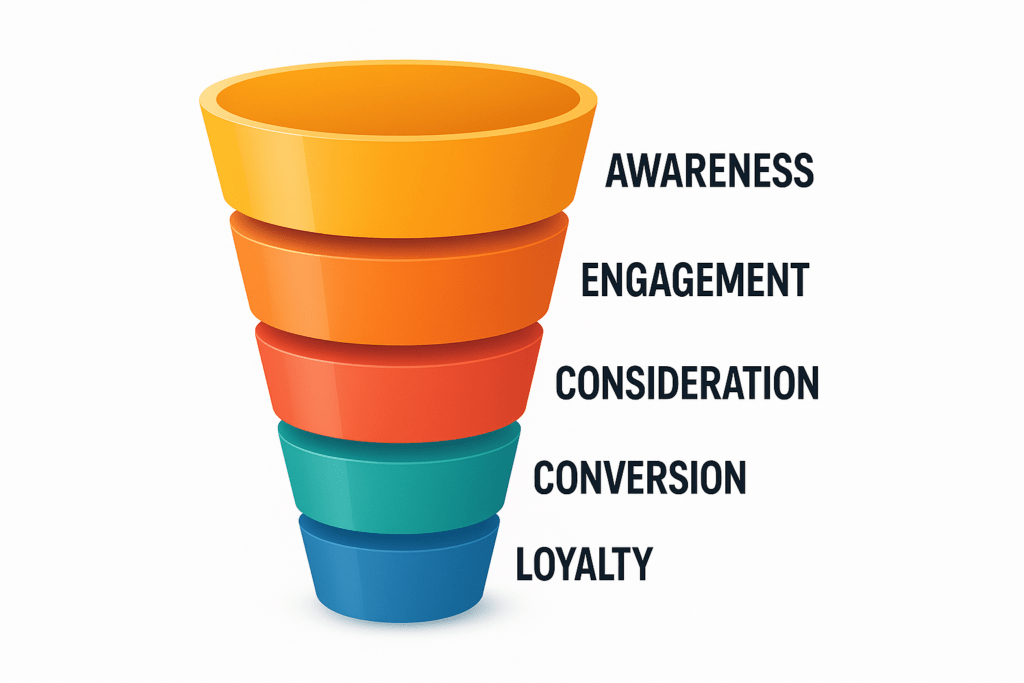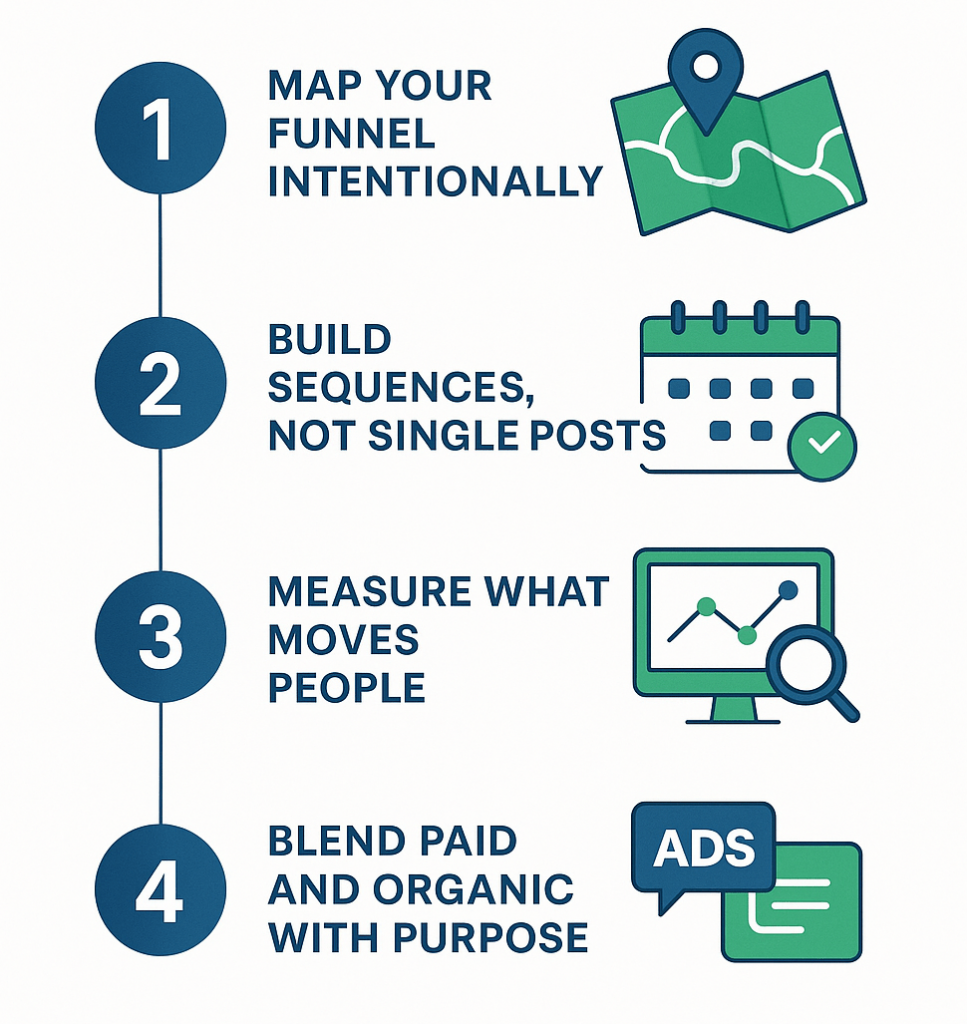
Don’t just post and hope. Design a social media conversion funnel that transforms visibility into conversions, step-by-step.
Social media does a lot for your brand: it drives visibility, builds trust, sparks connection, and fuels growth. However, without a system to guide your audience from discovery to decision, content alone isn’t enough.
The difference between brands that engage and brands that convert isn’t frequency—it’s funnel design.
A well-built social media conversion funnel doesn’t just create content; it also optimizes it. It creates direction. It turns your posts into stepping stones that guide someone from “just found you” to “just bought from you”—and beyond.
What follows is a high-converting framework you can build around. One that works for your business, your audience, and your goals.
What Is a Social Media Conversion Funnel?
A social media conversion funnel is a content-driven journey that leads your audience through every phase of the buying process, using the platforms they already spend time on.
It’s not a static template. It’s a dynamic strategy. One that adapts to where your audience is mentally and emotionally, and uses content to nudge them forward.
Each piece of content—from your most-viewed reel to your least-clicked blog—is either earning attention, building trust, or driving a next step. When those pieces are aligned under a funnel strategy, your brand not only grows, but it converts.

Why Most Funnels Fail on Social Media
If your feed is active but your sales aren’t moving, the problem isn’t a lack of effort—it’s a matter of alignment.
Most brands fall into one (or all) of these traps:
- They focus on visibility over direction. The content is getting views, but there’s no clear next step.
- They rush the sale. Instead of building trust, they go straight for the pitch—and lose the lead.
- They repeat the same message everywhere. Without content tailored to different stages, audiences tune out.
A strong funnel solves all of this. It guides without pushing. It informs without overwhelming. It moves people, not just metrics.
The 4 Stages of a Modern Funnel (Reimagined for Social)
Funnels used to be linear. Today, they’re dynamic. However, the psychological stages—awareness, engagement, consideration, and conversion—remain valid.
Here’s how to structure your funnel around today’s behaviors and expectations.
1. Awareness: Capture Interest Without Selling
This is where the relationship begins.
Your audience is seeing you for the first time. They’re not ready to buy—but they’re deciding whether to pay attention. Your goal? Relevance and resonance.
Smart content here includes:
- Reels that solve micro-problems or bust myths
- Shareable infographics that simplify something complex
- Relatable “you’re not alone” posts that reflect real pain points
The mindset shift you’re guiding:
From “I’ve never heard of this brand” to “This might be worth following.”
2. Engagement: Build Familiarity and Trust
You’ve earned a follow or a second view. Now it’s time to deepen the connection.
This stage is about consistency and clarity. Let your audience know what you do, who you help, and why it matters to them.
Effective content at this stage includes:
- Behind-the-scenes stories showing your process or team
- Thought leadership posts that share frameworks or beliefs
- Testimonials that reflect the outcomes you create
- Interactive posts—polls, Q&As, or comment prompts—that open dialogue
Don’t underestimate this stage. It’s the engine of your funnel—and it’s where brand loyalty begins.

3. Consideration: Make Your Value Undeniable
Now your audience is watching closely. They’re evaluating. Comparing. Thinking, “Could this work for me?”
This is your opportunity to eliminate doubt and highlight differentiation.
Strategic content includes:
- “Before and after” customer journeys
- Demo walk-throughs or use-case breakdowns
- Deep-dive carousel posts or lives that address FAQs
- Posts that contrast your offer with a common alternative
Your job here isn’t to push—it’s to prove. Reassure with clarity. Convince with context.
4. Conversion & Loyalty: Invite Action and Deliver More
Conversion is where your funnel becomes revenue. But it’s also where many funnels stop—and lose momentum.
Great funnels don’t just drive action, they design loyalty.
Content to publish at this stage:
- Clear, confident CTAs that remove friction
- Launch or promotion announcements with urgency
- Post-purchase follow-ups, education, and onboarding tips
- Loyalty-building content: referral bonuses, VIP access, sneak peeks
Remember: the post-purchase experience is a crucial part of the sales funnel. Treat your customers like future ambassadors.
How to Design Your Funnel for Long-Term Growth
Frameworks are powerful, but execution is where growth truly occurs. Here’s how to build your funnel into something that scales with your brand.

1. Map Your Funnel Intentionally
Start with clarity, not content. Identify:
- What’s the biggest problem your audience is trying to solve?
- What belief shift do they need to move forward?
- What kind of content will best facilitate that shift at each stage?
From there, reverse-engineer your content plan. The more intentional your message, the more efficient your funnel becomes.
2. Build Sequences, Not Single Posts
If your content doesn’t connect, it doesn’t convert.
Design mini-campaigns that lead somewhere:
- Day 1: Call out a pain point
- Day 2: Reframe it with new insight
- Day 3: Offer social proof
- Day 4: Present your offer clearly
- Day 5: Handle objections or reinforce urgency
This structure moves your audience from passive viewer to active prospect, with intention.
3. Measure What Moves People
You’ve mapped your funnel and built the right content—now let’s make sure it’s actually moving the needle.
For each stage, watch for:
- Awareness: Reach, impressions, follows
- Engagement: Saves, shares, comments, DMs
- Consideration: Website visits, link clicks, video completion
- Conversion: Purchases, sign-ups, inquiries
- Loyalty: Repeat purchases, referral traffic, UGC
Look for drop-offs, and ask why. Then optimize.
4. Blend Paid and Organic with Purpose
Organic content builds trust. Paid content builds scale.
Combine the two by:
- Retargeting your most engaged followers
- Promoting high-performing organic posts to cold audiences
- Using lead-gen ads that align with top-performing content themes
Funnels work best when your message is consistent, no matter how someone finds you.
Don’t Just Post. Lead.
Every piece of content should have a purpose. Every stage of the journey should be carefully designed. When you build your social presence around a funnel—not a feed—you don’t just grow your audience; you also cultivate a more engaged one. Growing your business.
A social media conversion funnel gives your content a job to do. It creates movement. It builds momentum. And most importantly, it converts consistently.
The brands that win on social aren’t just visible. They’re intentional.
Now’s the time to stop guessing and start guiding.
Summary
Most brands post without a plan, but real growth comes from strategy, not spontaneity. This guide breaks down how to build a high-converting Social Media Conversion Funnel that turns attention into action. Learn how to map the journey, craft content that fits each stage, and build a scalable funnel that drives results across platforms.
